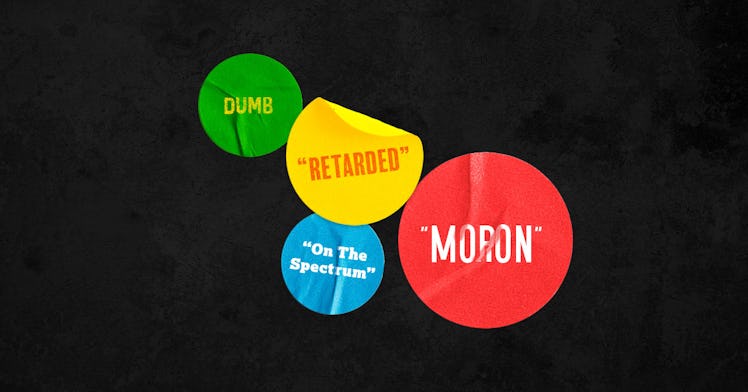The Problem With The “On The Spectrum” Armchair Diagnosis
Labeling someone with atypical behavior as being “on the spectrum” is damaging to people who are really autistic.

The fifth edition of the Diagnostic and Statistical Manual of Mental Disorders (DSM-V), the main source of psychiatric information for American doctors, officially codified Autism Spectrum Disorder (ASD) in 2013. The creation of ASD was a response to the growing understanding of neurodiversity and the medical consensus that autism is a disorder encompassing a variety of conditions that affect individuals with varying degrees of severity. ASD gives practitioners a new framework in which to diagnose autism. There are no longer distinct modes of autism, from Asperger’s to childhood disintegrative disorder. Now, the severity of autism is measured “on the spectrum.”
In the years since the release of the DSM-V, “on the spectrum” has been taken up by the public and used to speak to socially, culturally, and, mentally divergent behavior. In other words, it’s been co-opted by non-professionals to explain away behavior considered odd. It’s wrong, yes, but also potentially damaging to autistic people.
“On the spectrum” wouldn’t be the first term to become weaponized slang. Look at the term “retarded.” Mental retardation was a common diagnosis used to label people with intellectual disabilities in the early twentieth century. Mental retardation was considered the more nuanced diagnosis, replacing “moron” and “idiot” in medical parlance. But as those terms fell out of medical usage, they remained a rhetorical cudgel for labeling people who scored low on IQ tests.
Broad deinstitutionalization in the 1970s meant that the public started to have greater contact with people who have intellectual disabilities. At that time, the word “retarded” was still used as a medical diagnosis for anyone in the neurodivergent community. But the term was quickly turned into an insult. Everyone knew what it meant — being different, helpless, childlike, and intellectually deficient in an intractable way. But more importantly, it meant that being perceived as having any of those qualities was a terrible thing.
The use of the r-word has become strictly taboo. That makes sense because people with intellectual and developmental disabilities have become more integral parts of our communities. More exposure to neurodiversity has created a progressive movement that aims to recognize the strengths of all people. More care has been taken to understand people as individuals.
Like the term “mentally retarded,” the term “on the spectrum” is a refinement of a diagnosis. But whereas “mental retardation” was adopted because the previous words had become insulting, ASD came from doctors understanding there are no distinct genetic markers for specific autism disorders such as “Asperger’s” and “Rett syndrome.” A generalized cause for similar behavior traits requires an inclusive diagnosis that captures them all.
And that’s why the use of “on the spectrum” by laypeople to cast shade on weird behavior is all the more harmful. It harkens back to the bastardization of the term “retarded” as a way to demean people with a diagnosis while simultaneously demeaning people without a diagnosis. All of it stems from a deep lack of understanding of the lived experience of individuals with intellectual disabilities. “On the spectrum” may feel more harmless because it’s the more scientifically current term. But instead, it’s warping a diagnosis and spreading disinformation in an aggressive manner.
As armchair diagnoses go, “on the spectrum” is more likely than not to be incorrect. A person who has trouble socializing should not be called “on the spectrum” — they might have generalized anxiety or depression or may simply be introverted. Someone who is process-oriented to a wild degree, like Sheldon on Big Bang Theory, is not necessarily on the spectrum. They might just be, well, process-oriented.
That’s why occupational therapist Diana Fitts, founder of the Sensory Toolbox, says the pejorative use of “on the spectrum” is so hurtful. Fitts notes that aside from erasing the experiences of autistic people, using the term “on the spectrum” for people displaying any kind of atypical behavior can obscure real awareness of what autism actually is. “This can make it really challenging for people with ASD to have their needs taken seriously,” Fitts says.
She worries that “on the spectrum” might become the norm, much in the way that words like “moron” and “idiot” have. She suggests the only real way to combat this is through genuine questions that lead people, and particularly children, to real understanding about what it means to live on the autism spectrum.
But in the end, the real danger of using the term “on the spectrum” outside of a clinical context is that it erases personhood, not just of the person being labeled, but of all autistic people. It means their unique perspectives and lives are placed behind the mask of a diagnosis and are therefore rendered beyond our concern.
“It’s okay to ask genuine, good-hearted questions and to let children do the same,” Fitts says. “Open up a space for learning, and people will realize that, when using the term ‘on the spectrum,’ it may be more hurtful than they intend.”